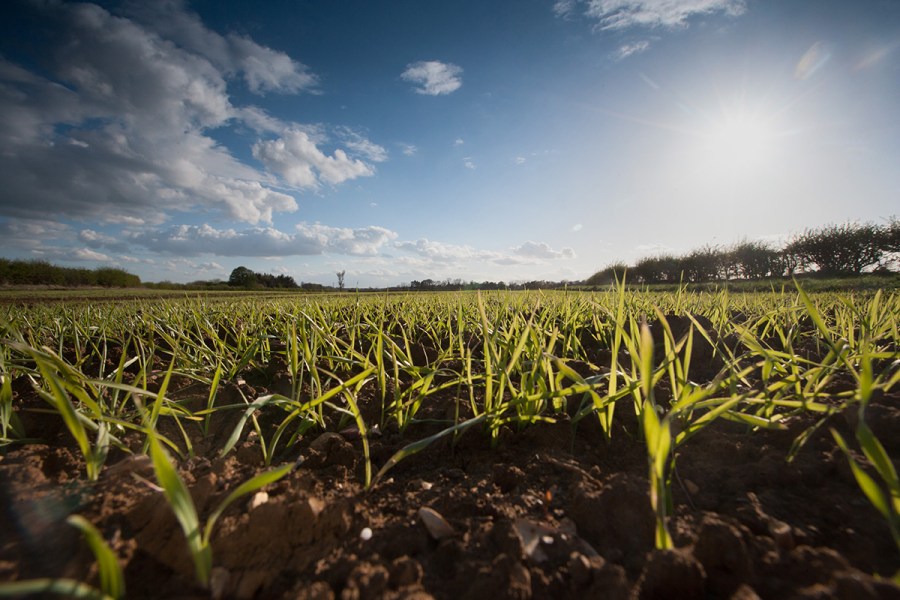As farmers seek to incorporate all available options to improve the resilience of their crops, CPM looks at how and where biostimulants fit into the picture.
“There only has to be a very slight increase in yield to achieve a return on that investment.” – JOSH STYCHE
By Charlotte Cunningham
Biostimulants have come a long way way in recent years, going from what was perceived as ‘muck and mystery’ to now more formally proven and scientifically backed products which can – in the right circumstances – add value to crops through improved tolerance to stress and better rooting, to name just a few benefits.
But has this changed uptake on farm? According to a recent survey undertaken by CPM and Interagro, 75% of participants revealed they’re currently using biostimulants on farm – with a further 8% stating they’ll be trying them for the first time this year. Of these participants, the majority (91%) are applying to winter crops, with a foliar spray being the product of choice for 75%.
“Biostimulants are definitely becoming more popular and I think there’s a greater degree of professionalism in the market as a whole – with regard to both products and how farmers are using them,” believes Interagro’s Alan East. “That said, I think there’s still a degree of hesitancy as I don’t believe they’re fully understood yet.
“There are a lot of different biostimulants out there claiming to do all sorts of different things. So I think before deciding to use a biostimulant – and a specific product – it’s vitally important to understand the nuts and bolts of exactly what’s in it.”
Agrii agronomist, Josh Styche, concurs and says he’s also noticed a shift in uptake during recent years. Josh is based in East Yorkshire, walking 4450ha annually, and says the past five years specifically have been important for the biostimulant market. “I personally didn’t go into using biostimulants in a big way until quite recently. Now – compared with five years ago – the product choice is better and inclusion in the programme can be tailored quite specifically to the individual requirements of the farm.”
He adds that typically, his clients are using foliar sprays with key target timings in late autumn and early spring. “I’ve used them in all sorts of ways, for example, on struggling oilseed rape crops to increase the canopy size pre-winter. Similarly with cereal crops in the autumn – particularly on heavier land – to help increase root mass. In the spring, applying a biostimulant pre-T0 helps wake up crops and encourage earlier growth.”
In terms of the benefits of biostimulants, the survey revealed a myriad of advantages, with growers seeing improvements to stress tolerance (51%), rooting (45%), nutrient uptake/nutrient use efficiency (37%) and tillering (33%).
As a result, plant health is perceived as greatly improved, with 69% noting positive changes in crop health as a result of the use of biostimulants. “I’ve definitely seen all of these benefits with biostimulants, particularly the ability to improve rooting,” explains Josh. “An area I think they’re really important for is helping to improve the plant’s defence mechanism against disease in the spring. Going forward, as our fungicide portfolio becomes increasingly reduced, I think products which enable this are ones that farmers should really be considering.”
Josh points out Zonda from Interagro as a product he’s seen to be particularly effective. Zonda is an amino acid biostimulant designed to help crops to reach their genetic yield potential and reduce the impact of abiotic stress by improving plant health. Containing essential amino acids for building protein, Alan says Zonda-treated crops have been proven in trials to be more likely to reach their potential.
Turning focus to the business end of the season, almost half of respondents (45%) have observed a moderate increase in crop yields since using a biostimulant. In contrast, 33% said they’ve seen no change – so why such a difference?
“It’s often very difficult to see a yield increase across the field without a direct comparison,” notes Alan.
“It also depends on the growing season,” he continues. “If it’s been a season with minimal stress points it’s likely growers won’t see such a significant result compared with untreated crops. This comes back to the point of using the right product in the right situation.” Josh agrees and says unless farmers are specifically measuring for yield differences in comparable fields it can be quite hard to quantify yield benefits – although many of his clients report very obvious visual differences where Zonda has been used. “That said, the inclusion of a biostimulant needs to give a positive return on investment, and it has done exactly that in Agrii and independent trails across a range of scenarios – particularly where we are trying to overcome crop stress”.
When it comes to quality improvements, the benefits are less apparent, with 61% of participants stating they’ve seen no specific improvements where biostimulants have been used. Alan suggests this could come down to how quality is being measured, whereas Josh says this is something he’d like to see studied further in official and farmer trials as improvements to quality can also help to justify return on investment.
FURTHER BENEFITS
Growers also had indifferent views about the impact of biostimulants on microbial activity and nutrient cycling. “All of these benefits are possible, however, quantifying them depends on how they’re measured,” notes Alan. “For example, microbial activity is something we’d be seeing in the spring but you have to be doing the soil samples at this time to see a difference. We know that isn’t always possible during busy periods.”
Looking at how benefits are monitored at both a plant and soil level, the majority of growers (60%) said they opt simply for a visual inspection, while others are also carrying out monitoring via SAP tissue testing and NDVI.
“There’s a lot of merit in carrying out more sophisticated testing, particularly SAP testing,” believes Alan. “From a sustainability perspective, if you’re looking at alternative options like biostimulants to improve plant health then it’s imperative to monitor the crop closely to see exactly what benefits you’re receiving for the investment you’re making.”
While Josh agrees, he says this type of testing often falls at busy pinch points of the year, meaning it’s not always realistic for farmers to undertake.
In terms of specific products, perhaps interestingly, the majority of growers said they’re quite flexible when it comes to product choice, with 73% revealing they don’t have a specific brand or formulation preference.
Looking at the Interagro stable of products, Bridgeway and Zonda are two of the most popular options. Derived from vegetal amino acids, Bridgeway promotes healthier crops by stimulating rooting and subsequent crop growth, optimising resource use efficiency.
It increases recovery and immunity against stressful growing conditions, which is something that’s becoming increasingly vital to growers, believes Alan. “We’ve invested a huge amount into both field trials and laboratory work to prove the efficacy, which has consistently proven that these biostimulants can really add value to crops.”
Josh says it’s the ability to tank-mix easily that makes the Interagro products first choice for him. “The tank-mix list is very wide and I’ve never had any issues when including them within programmes.”
APPLICATION TIMING
As well as choosing the right product for the job, Alan says a lot of the potential efficacy of a biostimulant comes down to applying it at the optimum time. “It’s a little like ourselves as humans – if we wait until we’re sick to take vitamins, it’s likely to have little impact. So, with biostimulants, it’s vital to get them on before the plants show any signs of stress symptoms so they’re fully primed to be resilient against these stress factors.
Only then can you use a biostimulant post-stressor to enhance recovery too.”
In terms of where they fit into the strategy, both Alan and Josh say biostimulants have a complementary role alongside other inputs – a view that 47% of survey respondents agreed with.
While there’s the opportunity to potentially look to reduce chemical inputs with well-placed biostimulants, this depends greatly on the season, notes Alan. “The job of our biostimulants is to make plants more resilient and with greater resilience comes an opportunity to look at reducing chemistry in a low- pressure season. However, in a high-pressure disease year, we absolutely still require those fungicides.”
Looking to the coming season, with the likelihood of extreme weather patterns high, incorporating a biostimulant into the plan could help to better prime plants before what’s ahead, suggests Alan. “Before Christmas, a lot of crops were looking quite well. While we know that’s not necessarily still the case for some, focus will likely be on protecting the remaining potential. This is where a biostimulant can fit in quite nicely and help to put the crops in the best position against whatever the season throws at them.”
Josh adds: “A lot of crops in my area are currently (mid-January) sat very saturated, which is going to leave them incredibly stressed. So, my plan coming into spring is to assess fields on a field- by-field basis as to whether they require a biostimulant in early March – which could be an application of Zonda – as early as I can, in the hope that this is going to offset that stress as much as possible.”
This article was taken from the latest issue of CPM.
For more articles like this, subscribe here.
Sign up for Crop Production Magazine’s FREE e-newsletter here.




